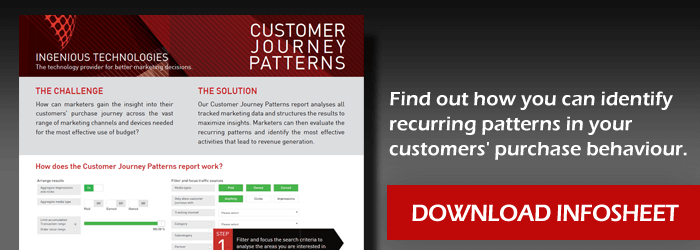Companies are constantly searching for ways to better understand their customers. Upon doing so, they can better adapt their strategy to attract them. And in attracting them better, they win sales.
Therefore, as good investigators do, marketers need to find answers to the following key questions:
- Who is interested in the products and services offered?
- What products do they like?
- Why do they like it?
- When do they tend to buy?
- Where do they make their purchases?
- How did they get to their decision to purchase?
Marketing technologies in the market are there to help make it that much easier. Yet not everyone can be trusted to base your strategic business decisions on. Here are the three most fundamental steps to make better marketing decisions.
1. Check your tracking
Ensuring the accuracy of the data you collect is the most important first step that is not to be missed. After all, any analysis is useless if the information fed is inaccurate. That’s why it is important to ensure that your tracking technology is in no way obstructing your view of the complete picture.
One of the biggest and most common problems with tracking is its battle against ad blockers. Ad blockers have a list of blocked tracking technologies, so tracking can be blocked when carried out under the tracking technology’s domain. Another big problem lies in the hidden interests of the tracking technology. For instance, technologies that also sell media could be providing you with subjective data that gives their media a boost.
That is why tracking is at its most accurate when done under your own domain – also known as first-party tracking – using an independent technology provider. This way, you can track all interactions with your website, and you remain in control of the data you collect and maintainownership of the data.
2. Set your conversion targets
If you think you can collect accurate data, the next question begs: What can you make out of your data?
To ensure all important events that took place on your website can be easily identified, you will need to set relevant conversion targets. The common ones available that technologies offer are sales and leads – but there are also many other relevant events that you should be able to define for yourself, such as signing up for newsletters, adding products to carts, and logging into their accounts. Tracking them will enable you to analyse the behaviour of customers in detail and relate this behaviour to partners, campaigns and ad media.
When registering a conversion target on Ingenious Enterprise, you also define the conversion target type to categorize your conversion easily. You can choose from the following options:
- Click-in: any successful arrival of a potential customer on a landing page.
- Video view: the watching of a video
- Lead: any target that allows you to identify a potential customer (through his/her name, email address, etc.) or a subscription for which a customer does not necessarily have to pay
- Engagement: any target that signalizes commitment from the customer, such as adding a product to a shopping cart, a registration for a customer account, a login to a customer account
- Install: the installation of an app on the customer’s device
- Sale: any conversion target which involves a customer paying for the product or service
- Acquisition: any sale that involves a long-term relationship between the customer and the advertiser, e.g. a contract for a communication service, or a subscription for a magazine
- Redemption: the usage of a voucher
You can also use conversion targets to differentiate between sales, e.g. by determining whether the customer is a new or recurring customer, or whether the customer had used a voucher.
With Ingenious Enterprise, you can also define whether the conversion ends the customer journey or not. For example, an “add-to-cart” conversion target usually does not end the customer journey, but it could still interesting to see how long it took before the sale occurs.
You can also define whether the conversion target is commercial or non-commercial and whether the target should be visible in the reporting of your partners. (Visibility is required for all commercial targets, for non-commercial targets it might not always be relevant.)
All of the above ensure that your data is now categorized in an easily understandable way, which leads us to the next step.
3. Analyse your data
The macro view: Performance reports
Suppose you want to see what were the best days and what were the worst. Or perhaps you want to see what the best performing ad media items are, what ad spaces are driving the biggest amounts of traffic, what advertisers are performing best, etc. To get a general overview of how your marketing strategies are working, you should be able to view such data (views, clicks, conversions) in your reports organised by the denominator you wish to investigate (day, product category, ad spaces), with the right order you wish (ascending, descending), and to the granularity you need.
However, this only gives you a rough estimate of how your marketing is doing. To really understand your customers, you need to look at it more closely.
The micro view: Customer journey
Your marketing technology should be able to take all the marketing data that you have gathered and structure them to show you patterns of recurring customer journeys. This means you should be able to easily identify the most important winning combinations of channels, specific to their order in the customer journey. Furthermore, you can focus on specific marketing activities and even single partners and their contribution in the customer
With Ingenious Enterprise, you will be able to view the following information easily:
- all your customer journey patterns according to the number of conversions they have accumulated
- the order value they have collected
- the average number of touchpoints customers have interacted with in this specific pattern
- the average number of on-page activities as a result of this pattern
- a counter for the accumulation of transactions and revenue marking the relevant information for commercial decisions based on this analysis – in other words, how many patterns are covering 80% of your total sales
The final key
While that was the three simple rules to understanding your customer, there’s more if you wish to make an impacton your business.
Apart from ensuring you gather accurate data, structuring the data and analysing the data, you need to ensure your data is actionable. Regardless of whether you want to do a top-down or granular analysis, your technology is only a true time-saver when you can apply the relevant changes to your attribution models and commission rules in real-time. This ensures you can make your data-driven decisions and optimize marketing investments immediately.






